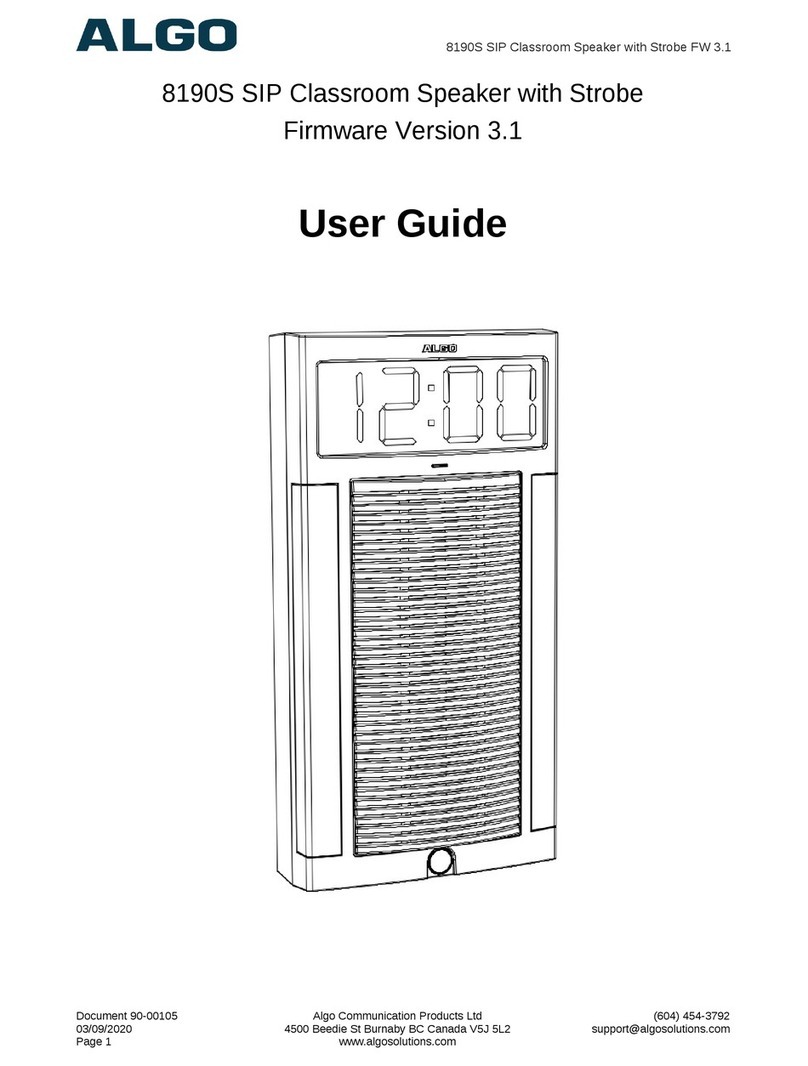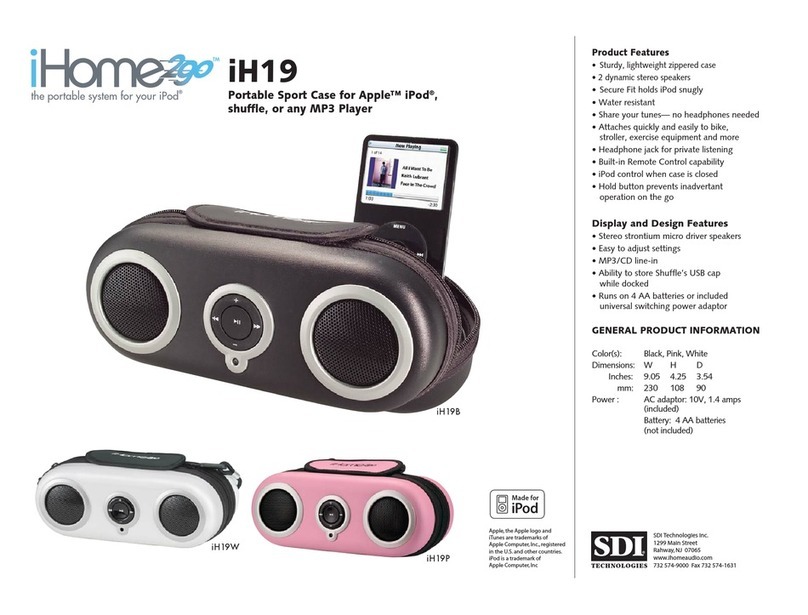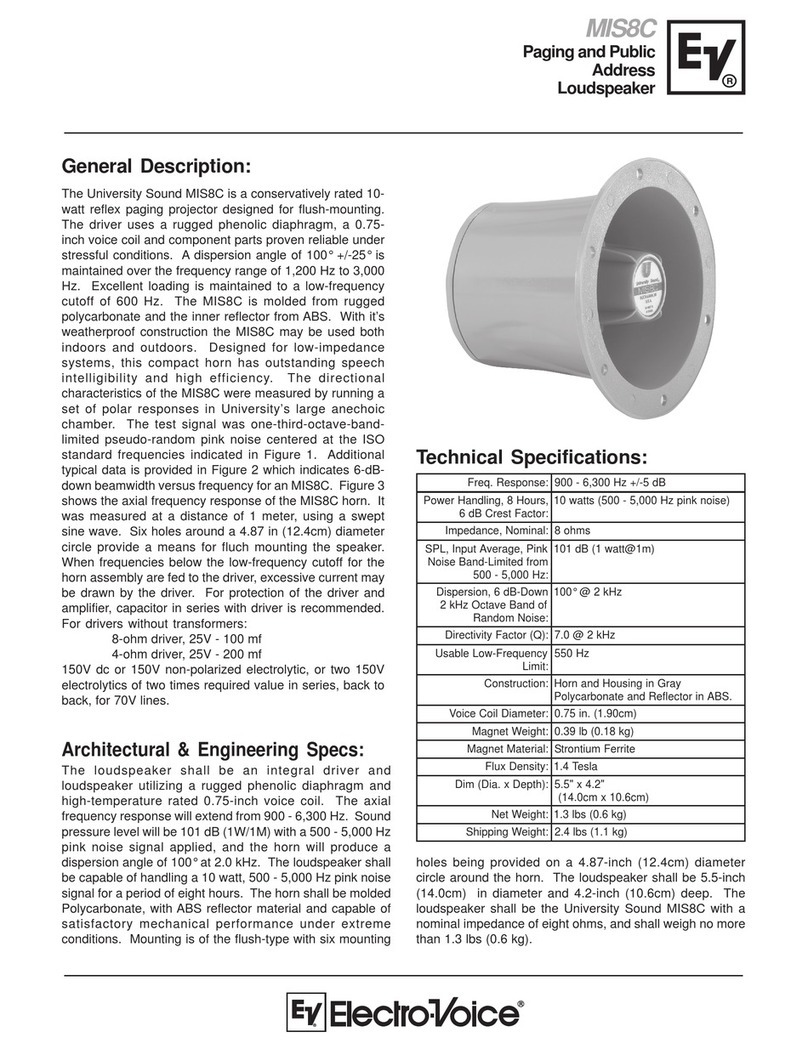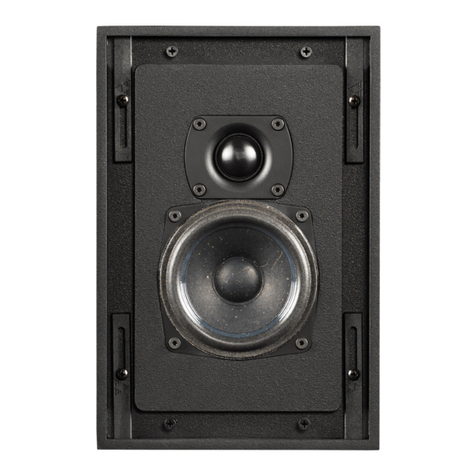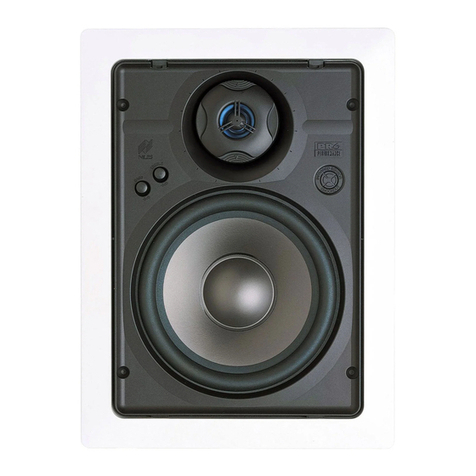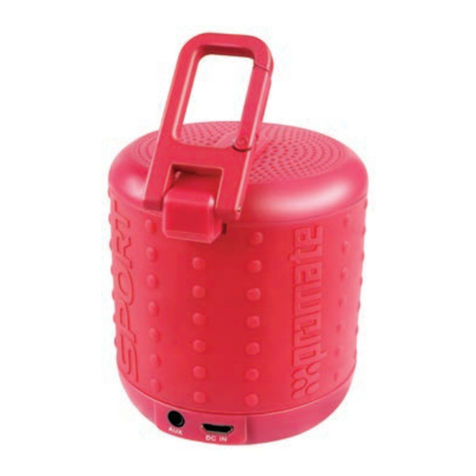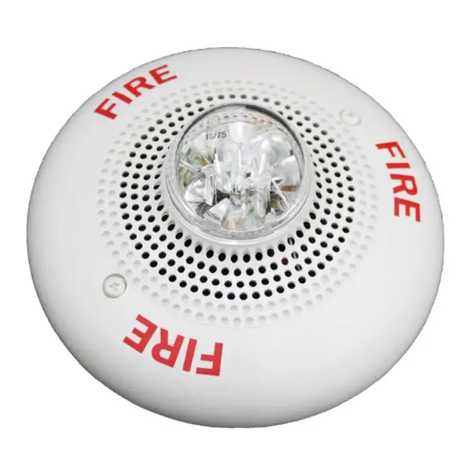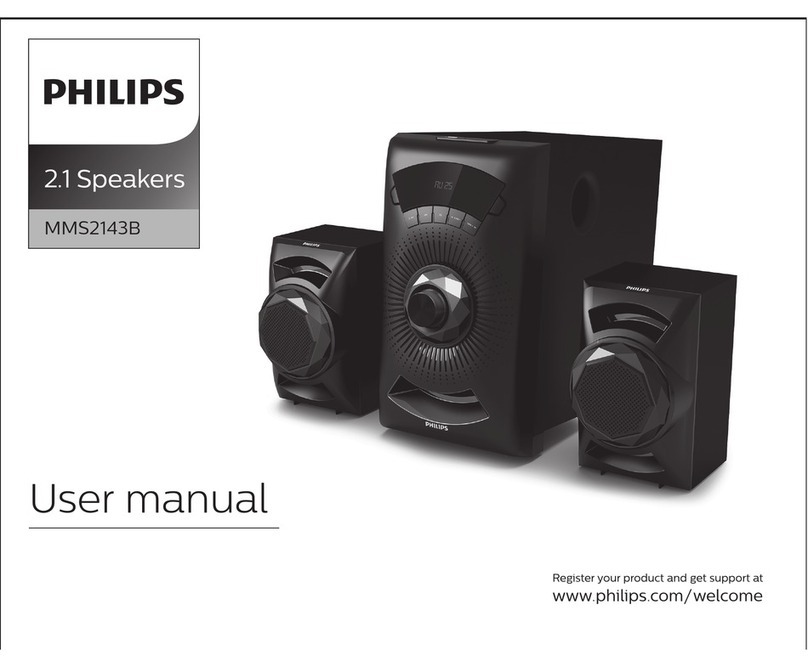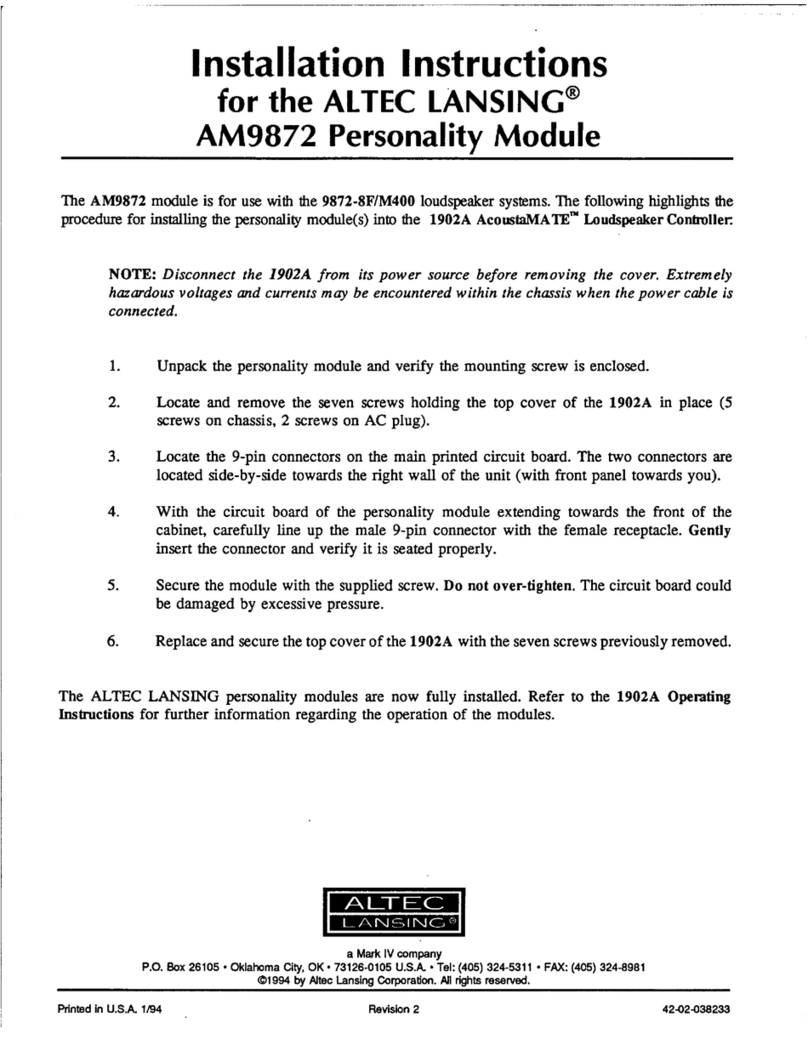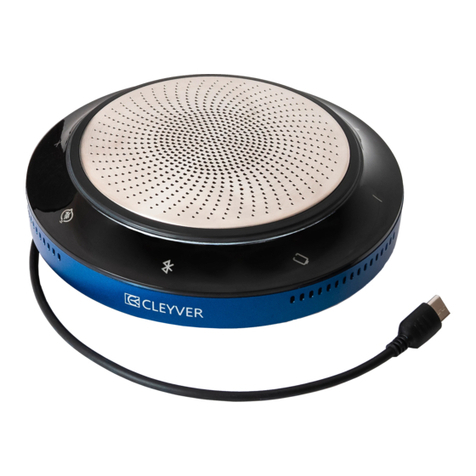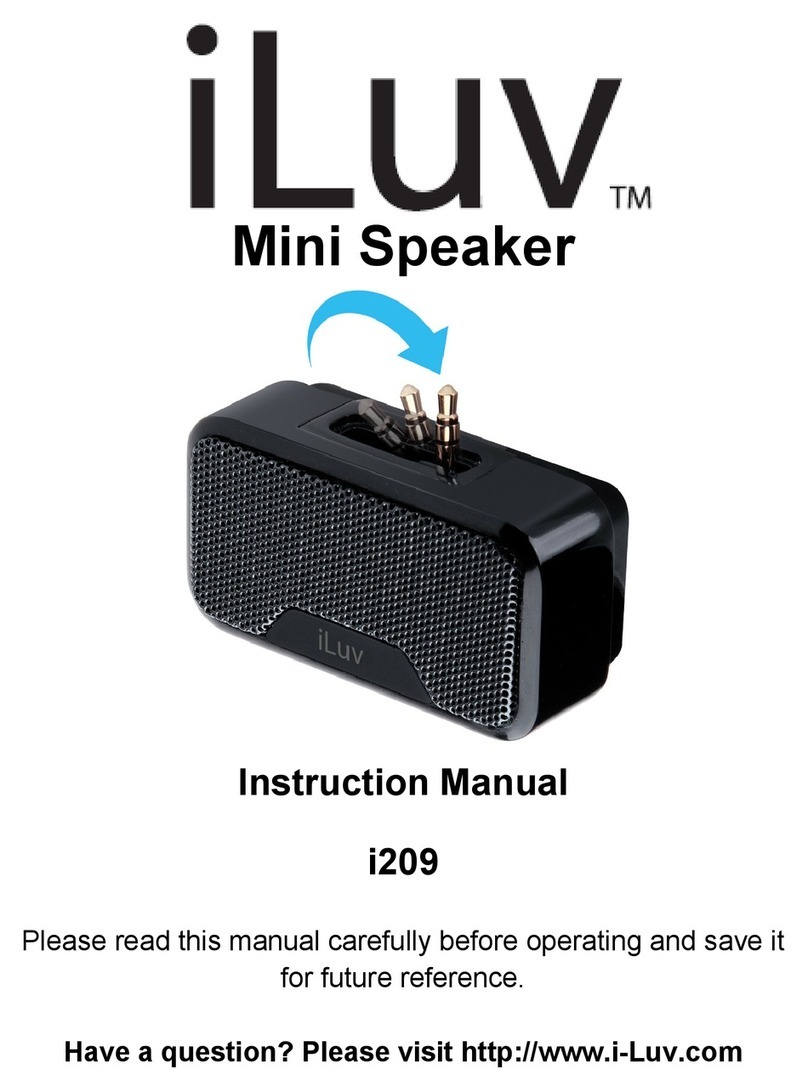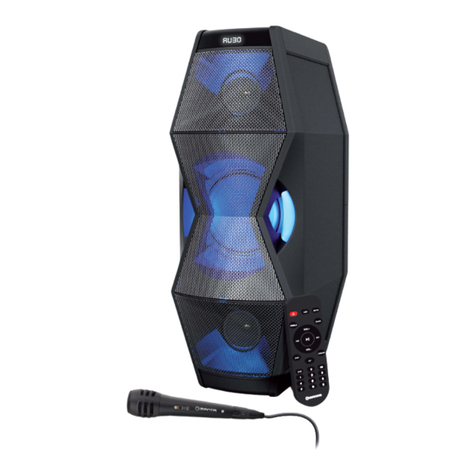Miller & Kreisel Sound LCR-750THX User manual

Miller & Kreisel Sound Corporation
10391 Jefferson Boulevard
Culver City, CA 90232 USA
(310) 204-2854 FAX (310) 202-8782
www.mksound.com
© 1999 MILLER & KREISEL SOUND CORP.
operationmanual
LCR-750THX
Center-750THX
THX Select Front Speakers
Manufactured under license from Lucasfilm Ltd. U.S.
PatentNumbers5,043,970;5,189,703;and5,222,059. For-
eign patents pending. Lucasfilm and THX are registered
trademarks of Lucasfilm Ltd.

LCR-750THX & Center-750THX page 2
1. INTRODUCTION...........................................................................................................3
2. THE HOME THX AUDIO SYSTEM..........................................................................3
3. PLACEMENT OF YOUR M&K THX SPEAKERS................................................................3
4. SPEAKER HOOK-UP & USAGE.............................................................................4
HOOK-UP...........................................................................................................................4
5. THE M&K HIGH-FREQUENCY PRISM SYSTEM...........................................................5
6. CENTER-750THXCENTERCHANNEL..................................................................................5
7. OPTIMIZING SPEAKER PLACEMENT...............................................................................5
8. HOME THEATRE USAGE...................................................................................................6
CENTER CHANNEL.......................................................................................................7
9. SATELLITE/SUBWOOFER PHASING TEST....................................................................8
10. SPEAKER DAMAGE & HOW TO AVOID IT.......................................................................9
11. BI - AMPLIFYING YOUR SPEAKERS WITH M&K HIGH-PASS FILTERS.........................9
12. IF YOU NEED SERVICE OR SET-UP ASSISTANCE.....................................................10
13. CABINET MAINTENANCE................................................................................................10
14. USEWITHM&KSTANDSANDOMNIMOUNTBRACKETS...............................................10
15. SPECIFICATIONS.......................................................................................................11
DIAGRAMS
FIGURE 1 SPEAKER WIRING..................................................................................4
FIGURE 2 SEPARATION BETWEEN LEFT & RIGHT SPEAKERS............................6
TABLE OF CONTENTS

LCR-750THX & Center-750THX page 3
1.INTRODUCTION
Congratulations! Your new M&K THX Select speaker system will give you years of unmatched enjoyment and
excitement while listening to your favorite musical and audio/video sources.
Weencourageyoutoreadthisowner’smanual,asthereisagreatdealofinformationprovidedheretohelpyou
achieve the best possible performance.
If you have any questions about your speaker system, please contact your M&K dealer or call the M&K factory
directly at (310) 204-2854, from 8:30 AM to 5:00 PM Pacific Time, Monday through Friday. We will be happy to help
you with any question, no matter how simple or complex it may be.
This manual gives you basic hook-up instructions first, followed by more detailed technical, installation, and
service information.
2. THE HOME THX AUDIO SPEAKER SYSTEM
Your choice of an M&K Home THX Audio speaker system assures you of achieving the state of the art in
hometheatremusicandvideoreproduction. ThepreciseandexactingstandardsdevelopedbyLucasfilm'sHome
THXdivision,asappliedbyM&K's engineeringteam,assurethatyou willheareveryelementoffilmsound -from
the softest brush of an object against an actor's clothing to the awesome impact of effects such as an exploding
planet - with the same sonic quality heard by the film's director and sound designer as they created the final mix
of sound on the studio's dubbing stage.
TodothisinahomeenvironmentrequiresdifferentequipmentandstandardsthanarefoundinaTHXmotion
picturetheatre. The standards developed for Home THX Audioarecriticallyimportanttoachievingthefollowing
performance attributes:
- wide frequency range, extending to the limits of audibility
- smooth, naturally balanced overall sound
- excellent dialog intelligibility
- wide dynamic range with extremely low distortion
- well-matched timbre (tonal balance) between front speakers and surrounds
- precise localization of specific sounds (as in special effects)
- envelopment by ambient soundfield (without any localization of individual speakers to distract
from the action on-screen
- superb performance with musical sources
The unsurpassed quality of your M&K Home THX Audio speaker system means that all of the excitement
and emotional involvement of films and music will be brought to life in your home. Turn down the lights, and let
the experience begin!
3. PLACEMENT OF YOUR M&K THX SPEAKERS
Your speakers can be installed in a wide variety of locations. They can be placed on stands, shelves, or
bookcases, or permanently mounted using brackets, direct wall attachment, or a ceiling suspension system.
Your speakers have threaded mounting hardware permanently mounted into the cabinet in different
locationson the speaker'sbackbaffle. Theseallow you tomountthespeakers in awidevarietyoflocations, and
toorientthemforthebestpossiblesound. Thereisatwoholepatternusinginsertsthreadedfor1/4-20hardware
(1/4 inch in diameter, and 20 threads per inch), and a single 3/8" threaded insert.
These mounting patterns accommodate M&K speaker stands and mounting brackets. These mounting
holes can also be used to attach the speakers to Omnimount brackets. They match the Omnimount #75 pattern
and the Omnimount RST-53 3/8" mount).
You can place your speakers virtually anywhere in the room, but certain locations are better than others.
Ingeneral,locatethemawayfromobstructionsthatwouldinterferewiththedirectpath fromthespeakerstoyour
ears (such as walls, furniture, lighting, plants, etc.). They will sound better when they are around ear height, or
when angled towards your favorite listening location.

LCR-750THX & Center-750THX page 4
FIGURE 1
SPEAKER WIRING
AMPLIFIER
RIGHT
+
_+
_
LEFT
_
+
_
+
Both the LCR-750 and Center-750 are magnetically shielded. This means that they can be placed close to
atelevisionmonitorwithoutdistortingthepicture. Ifyouplacethespeakerdirectlyontopofalargescreendirect-
view monitor, there is some slight possibility of picture distortion. If that occurs, you may need to move the
speaker a few inches or to separate the speaker from the television by a similar distance. Call the factory if you
have problems.
For more detailed placement information, see Section 6 on page 5.
4. SPEAKER HOOK-UP
The sound quality that you get from your speakers can be affected by the type of speaker wire that you use
to connect them. While it is possible to use speaker wire as thin as 22 gauge to hook your speakers up, wire of
less than 16 gauge will compromise their sound quality. We strongly recommend using the heaviest gauge wire
possible. Your special M&K 5-way binding post input terminals will directly accept wire as heavy as 4 gauge!
Forwirerunsofupto10feet,16gaugewireisacceptable. Forrunsupto20feet,youshoulduseaminimum
of14 gauge. For upto 30 feet,use a minimumof 12 gauge,and over 30feet should use10 gauge. See theTHX
Installation and Operation Manual for more information.
There are a very wide variety of premium speaker cables available from a number of specialist manufac-
turers. We do not endorse any specific brand of premium cable, but we do recommend the highest quality cable
that fits your budget. Beware, though —with cables, expensive is not always better. If you have any questions,
contact your M&K Home THX dealer for advice.
WIRING
ThePositive(+)leadfromyouramplifierorreceivershouldbeconnectedtotheRED (+)"INPUT"terminal,
and the Negative ( — ) lead from your amplifier or receiver should be connected to the BLACK ( — ) "INPUT"
terminal. See Figure 1 above.

LCR-750THX & Center-750THX page 5
5. THE M&K HIGH-FREQUENCY PRISM SYSTEM
Your LCR-750 and Center-750 speakers utilize M&K's exclusive High-Frequency Prism System to optimize
imagingandcoverage of sound throughoutthe listening area. This system isdesigned to take into accountthe effect
of the curved mesh metal grilles on your speakers. Therefore, your speakers are designed for the best sound when
the grilles are in place. We recommend that you leave the grilles on the speakers for all listening.
You will note that the tweeter in your LCR-750s and Center-750 speakers is mounted at a slight angle (4.7
degrees). This mounting is an integral part of the High-Frequency Prism System.
Whenthespeakersaremountedproperly,thetweeterwillbeangledawayfromthelisteningposition. Thatmeans
that the left and right channel speakers should be placed with the tweeter angled towards the nearest side wall. The
leftchannel speaker's tweeter shouldpoint towards the left wall, and theright channel speaker's tweetershould point
towards the right wall.
The center channel speaker should be placed with the tweeter pointing up when it is sitting above the listening
position(such as when itsits on top ofa projection television set). The center channel speaker should be placed with
the tweeter pointing down when it placed underneath the television screen.
When the speaker is mounted as described above, its stereo imaging and coverage of sound are optimized for
a very wide listening window that extends from the on-axis position towards the center of the room. If the speaker is
mounted with the tweeter pointed in the other direction, its sound quality will be adversely affected.
6. CENTER-750 CENTER CHANNEL
The Center-750 speaker is designed to match the LCR-750, so all instructions apply to both speaker versions.
The Center-750 is designed to be oriented horizontally and located above or below your television screen. For more
discussion of center channel speaker placement, see CENTER CHANNEL on page 6.
7. OPTIMIZING SPEAKER PLACEMENT
The sound quality produced by your speakers can be significantly enhanced by careful attention to their
placement. While we understand that you may not redesign your room to accommodate your speakers, coming as
close as possible to the ideal placement will give you much better sound.
Theleftandrightchannelspeakerscanbeorientedeitherhorizontallyorvertically. TheCenterchannelspeaker
is designed for horizontal orientation (tweeter and woofer drivers next to each other), and can be angled (vertically)
towards your listening position.
Three factors are important in getting the best sound. They are:
A. Height (or angle).
B. Location away from room walls or reflecting surfaces.
C. Separation between Left and Right speakers.
A. HEIGHT (OR ANGLE)
YourM&Kspeakerswillalwaysdeliversoundsuperiortoconventionalspeakers,regardlessofwhereyoulocate
them. However, because they are designed for very fast and accurate transient response, they achieve even better
sound quality, and the flattest frequency response when properly oriented relative to your ear.
Ideally, the tweeters should be at the same height from the floor as your ears, when you are sitting in your main
listeningposition.
Ifyouhavethespeakersmountedaboveorbelowthisheight,theysoundtheirbestwhenyouanglethespeakers
so that the tweeters are aimed at your ears when you are in the main listening position.
B. LOCATION AWAY FROM REFLECTING SURFACES
Yourspeakersshouldbelocated,wheneverpractical,awayfromwalls,thefloor,furniture,oranyotherreflecting
surfaces. Dothebestyoucan. Objectsclosetothespeakerwillreflectsound,andthisreflectedsoundarrivesatyour
ear slightly later than the direct sound, which blurs sonic imaging and makes transients seem muted.

LCR-750THX & Center-750THX page 6
LEFT SPEAKER RIGHT SPEAKER
Line X - Y should equal
line A - B. (line A - B appears
longer in this diagram due
to an optical illusion).
B
XY
A
FIGURE 2
SEPARATION BETWEEN LEFT & RIGHT SPEAKERS
The delay is very slight, so instead of hearing an echo, you hear a "blurred" sound with less clarity that is not as
sharp and distinct as it should be. This time delay also affects frequency response and sonic imaging.
Ifthespeakersareon atelevisionsetorshelves,locatethemonthefrontedge,sothereisnoflatsurfacedirectly
infront of them. If the speakers will sit close to wallsorotherlargeobjects,leaveasmuchspace as possible between
the speaker and the object. Ideally, your Speakers will be several feet from the nearest surface, but in most rooms
compromise is necessary.
C. SEPARATION BETWEEN LEFT AND RIGHT SPEAKERS
Here is a formula for achieving the ideal left to right stereo imaging. Think of a triangle formed by the locations
ofthe LeftandRight speakers andyourlistening position. Ideally,thesubtendedangle formedshouldbebetween 45
and50degrees. Roughly,thismeansthattheLeftandRightspeakersshouldbeseparatedbyaboutthesamedistance
thatyouaresittingbackfromthespeakers. Inotherwords,ifthedistancefromyourlisteningpositiontothepointdirectly
between the speakers is 10 feet, place the speakers so their centers are 10 feet apart. See Figure 2 on page 6.
On Figure 2, the length of line A - B should be about the same as the length of line X - Y. (They may not seem
to be the same in this diagram due to an optical illusion).
Try to follow the formula as close as you can. You can fine tune the placement by listening to a source with an
image (such as a vocalist) centered between the speakers. When listening in stereo (no Center Channel speaker),
movethespeakersclosertogetherorfarther apart in small increments until you hear the sharpest andmostcohesive
image, especially in the phantom center. You may also want to angle (or "toe-in") the speakers slightly. This often
improvesthesharpnessofthestereoimage,reducesroomcolorations,andprovidesawiderseatingarea. Theangled
front baffles of your speakers also provide this benefit.
8. HOME THEATRE USAGE
LEVEL-MATCHING
The factor most critical to achieving excellent Home Theatre performance is level-matching the three front and
twosurroundchannels. Thisisevenmoreimportantthantimbre-matching.Westronglyrecommendthatyoupurchase
aRadioShackSoundLevelMeter(availableforlessthanabout$40,andgettheanalogmeter,notthedigital)anduse
it to measure the output of the speakers when playing the test tones generated by your processor or receiver.
Setthemeter to the "C" weighting scale, andusingyour amplifier or receiver's internal noisecalibrationtest, set
thelevels so that all channelsmeasurethesamelevel. WHENEVERPOSSIBLE,DO NOT CALIBRATE LEVELS BY
EAR! Using a meter is an inexpensive way to be certain that your system is calibrated properly.

LCR-750THX & Center-750THX page 7
TIMBRE-MATCHING
OneofthemostimportantfactorsinachievingexcellentHomeTheatreperformanceistimbre-matching. Onfilm
soundtracks, specific sounds are often moved from left to right or from front to back in the room. When the speakers
reproducingthese sounds have dissimilar characteristics, therewillbeanaudiblediscontinuity when the sound shifts
from one speaker to another.
Timbre-matched speakers have very similar tonal characteristics and sound, which come from three critical
elements: similar or identical drivers; similar or identical crossovers; and similar or identical frequency response. In
full M&K systems, these elements have been addressed. You can be assured that the system can achieve the full
potential of Home Theatre sound.
When you have a Home Theatre system, speaker placement becomes extremely important, as you will be
balancingfour or five (or more) speakers rather than two. The following guidelines are for a five-channel Pro-Logic or
5.1channelAC-3system,butifyoudonothaveaCenterchannel,theinstructionsfortheotherfourchannelsstillapply.
CENTER CHANNEL
The Center channel speaker in any multichannel system is the most important speaker in the system. This
speakeroften producesmoreoutputthantheleftandrightspeakers
combined
. Thisspeakershouldbeofthehighest
possible quality, and as similar as possible in response and radiation pattern to the left and right speakers. Three
identical speakers are best, unless the center channel is designed to work with a set of left and right speakers.
ItisalsoimportanttohaveasmuchamplifierpoweraspossiblefortheCenterchannel. Asaminimum,thethree
frontchannelsshouldbeidenticalinpoweroutput,butitisbetteriftheCenterchannelhasmore. Ifyouhavelesspower
in the Center channel, this will be the limiting factor in the total output capability of the system when watching and
listening to video sources.
The Center channel speaker should be located as close as physically possible to the television or projection
screen, preferably just above or below the screen. If that is not possible, then just to the left or the right of the screen
may be acceptable. The Center-750's Phase-Focused crossover will always give you smooth and even coverage
throughout the room.
Ifthetelevisionisnotinthecenteroftheroom(ornotcenteredbetweentheLeftandRightspeakers),theCenter
channelspeakershouldstillbeascloseaspossibletothescreen--evenifitisoutsidetheleftandrightspeakers(such
as a TV located in a corner of the room outside the stereo spread of the left and right speakers). Good results can be
achieved in unusual configurations when the Center speaker is as close as possible to the screen.
TheLeft and Right front channelspeakers in a Home Theatresystem should be placedthe same as the leftand
rightspeakersinastereosetup. Somelisteners,however,mayprefertoreducethedistancebetweentheleftandright
speakers to bring the size of the acoustic image closer to the size of the screen image.
Forexample, with a25"direct-viewtelevision, you wouldwantthespeakers closer togetherthanyouwouldwith
a 100" projector. One recommendation is to separate the speakers by 1.5 times the diagonal screen size; another is
to place the left and right speakers to create a 45 degree angle with the main listening position.
Thereisagreatdealoflatitudeinthisarea,asitisoneofpersonalpreference(especiallyifyouwilllistentomusic
without video).
It is also preferred that the speakers be equidistant from the listening position. Equidistant usually means that
whenthecenterspeakerisontopofthetelevision,theleftandrightspeakerswillsitinfrontoftheset(theywillbefarther
fromthewallbehindtheTVthanthecenterspeaker). Ideally,thespeakersshouldbeatthesameheightasthescreen,
but it is much more important that all three speakers be at as close to each other's height as possible. If the center is
muchhigherorlowerthantheotherspeakers,theeffectcanbedistracting. Angling,ortoeing-inthespeakers,to aim
at the listening position often improves imaging.
WhenusingaCenterchannelspeaker,youhaveextraflexibilityinplacingtheleftandrightspeakers,astheCenter
channel speaker will tie most dialog and effects directly to the screen.
SURROUND CHANNELS
Surroundspeakerscanbeinstalledinawidevarietyoflocations,butinsomeroomstheirinstallationcanbequite
achallenge toinstall. Ifyouhaveany questions, pleasedon'thesitateto contact yourM&Kdealeror the M&Kfactory.
We will be happy to discuss your system with you.
We recommend placement of the surround speakers on the side walls of the room, two to three feet above the
listeners'heads,eitherdirectlyadjacenttothelisteningpositionorbehindit. Youcanaimthespeakerstofiretowards
each other (across the listening area), or you can aim them to fire towards the back wall at an angle. The surround
speakers should not be in front of the main listening position if possible.

LCR-750THX & Center-750THX page 8
If you mount the surrounds on the side wall behind the listening position, they can be aimed towards each other
orangled towards the back wall orthesidewallsurfacedirectlybehind them. By reflecting sound behind the listening
position, you may increase the sense of envelopment in the sound.
Ifyouwantorneedtomountspeakersonthebackwalloftheroom,thereareseveraloptions. Youcanaimthem
so that they fire towards each other (so they fire along the back wall); you can aim them towards the front wall of the
room; or you can angle them so they fire toward the side walls. Symmetrical arrangements work best.
Thespeakersshouldbeaminimumofa fewfeetawayfromthenearestlistener. Ideally, thesurroundspeakers
should not call attention to themselves as separate sources of sound.
Ifthesurroundsmustbelocatedclosetothelisteners,aimingthemattheroomwallsoreventheceilingcanhelp
to reduce any directional effect. As described above, this can produce a desirable result even in rooms where the
surround speakers are an adequate distance from the listeners' heads.
Ifthesurrounds cannot be placed onawall, try placement on tablesor the floor to the sidesof the main listening
position,firinguptowardstheceiling. Thiscanworkverywellinenvironmentsthatdonotallowpermanentattachment
of speakers to the walls.
Some listeners prefer to use multiple pairs of surround speakers. While this is not necessary, it can provide a
broaderanddeeper surround effect, with bettercoverage in very large rooms. When usingmultiple pairs of surround
speakers,asymmetricalinstallationpatternworksbest. Forexample,ifyouareusingtwopairsofsurroundspeakers,
onepaircouldbemountedonthebackwalloftheroom,mountedequidistantfromthebackcorners,withtheotherpair
mounted on the side walls of the room, equidistant from the same back corners.
The surround channels can be installed in a wide variety of locations, but because they are usually mounted on
the walls of the room, they can be a challenge to successfully install. If you have further questions, please call us at
the M&K factory, and we will be happy to discuss them with you in detail.
SUBWOOFER
SubwooferlocationforHomeTheatresystemsisessentiallythesameasformusicsystems. SeeourSubwoofer
operationmanual for more details. Remembertoleave2- 3 feet ofclearancebetweenanytelevision and subwoofer,
unless the subwoofer is magnetically shielded.
The preferred connection for the subwoofer is a subwoofer output from the amplifier or controller. This insures
that a full bass signal is being fed to the subwoofer. If you do not have such a subwoofer output jack, connect the
subwoofer to the front Left and Right channel amplifier outputs (do not use the Center channel).
VERYIMPORTANT:WhentheSubwooferisconnectedtotheLeftandRightamplifieroutputs,andthecontroller
isinPro-Logicmode,the switchonthe Pro-Logiccontrolunit labelledCenterchannelWIDE/NORMAL must beset to
the NORMAL mode. If the switch is set to the WIDE mode, the bass content of the Center channel will not be fed to
the Subwoofer, and you will lose a significant amount of bass.
9. SATELLITE/SUBWOOFER PHASING TEST
InanysystemusingasubwooferseparatefromMainspeakers,aphasingtestmustbeperformedtoinsuregood
bass blending. This test insures optimum sound in the critical bass frequencies where your Subwoofer and Main
speakers overlap.
Playa familiar CD, DVD, LP, or tapewith steady, consistent bass content through yoursystem. Listen carefully
to the "mid-bass" region of 75 - 125 Hz. This is the part of the spectrum where electric or string basses and drums
predominate. Then reverse the phase of either the subwoofer or BOTH Main speakers.
If your Subwoofer has a PHASE switch on its back panel, move it either from (+) to (—) or vice versa.
IfyourSubwooferdoesnot have a PHASE switch, it takes a bitmorework. Youwillhaveto change the Positive
and Negative speaker inputs on the back of BOTH Main speakers.
You can do this at the back of both Main speakers, or at the Subwoofer's TO SPEAKERS terminals, but never
atbothlocations. TheleadthatwasonthePositive(+)terminalshouldbeswitchedtotheNegative(—)terminal,and
vice versa. When switching speaker wires, take care to protect your amplifier. Make sure that the wires do not touch
each other when you are making the switch. As a safety measure, we suggest that you turn the amplifier off before
making the switch.
Nowlistentothesamemusicalpassageasyoudidearlier,concentratingonthemid-bassregion. Ifyouhearless
bass, the original connection (or switch position) was correct. If you hear more bass, the new connection (or switch)

LCR-750THX & Center-750THX page 9
is correct.
YouneedtoperformthistestbecausewhenMainspeakersarelocatedseparatefromaSubwoofer,eachspeaker
is at a different distance from your ear. In some cases, the difference will be just enough so that the output from the
Subwoofer arrives out of phase with the output of the Satellites. When this happens, that critical mid-bass is actually
cancelled. You should re-do this test any time you move your speakers.
If you want to experiment further, move the Main speakers either towards or away from your listening position,
making changes in small increments. This will "focus" the system's sound to its optimum. When you hear the best
combinationofstereoimagelocalizationandmaximumimpactandoutputinthemid-bass,youhavetheideallocation.
10. SPEAKER DAMAGE & HOW TOAVOID IT
An important factor to consider with any loudspeaker system is the potential for speaker damage. Even though
your M&K Speakers have extremely high power handling ability (especially for Main speakers), they still can be
damaged by relatively low powered amplifiers.
While very few M&K Speakers are actually returned for service, the vast majority of those returned are not for
manufacturing defects. Instead, they are returned because they have been overdriven, almost always because the
amplifierorreceiverusedwasdrivenintoclippingdistortion. Thisdamageisconsideredabuse,andisnotnecessarily
covered under warranty.
This clipping distortion occurs when the demands of the music are greater than the amplifier's available power.
Itcanoccurat20wattswithasmallamplifier,orat400wattswithalargeamplifier. Whenthishappens,theamplifier's
output waveform (which should look like a smooth arc) is "clipped" off, exhibiting a flat top instead of the arc.
This"clipped"waveformcontainsmultiplesoftheoriginalamplifiedfrequencies,sometimesathigherlevelsthan
the original signal itself. For tweeters, this can be very damaging, as this distortion is well above the audible range
(where you are unable to hear it), and where the tweeter is most vulnerable to damage.
Whenan amplifier "clips", it generatesa high level of highfrequency energy (much higher thannormal program
material) which passes through the crossover to the tweeter. This energy can overheat the tweeter in a matter of
seconds and destroy it.
When this happens, the sound becomes harsh and grating, and a break-up is often audible in the bass
frequencies. Itwillbecomeuncomfortabletolistento,especiallywhencomparedtoaslightlylowervolumelevel. When
you are listening at high volume levels, be aware of the onset of clipping distortion, and turn the volume down slightly
if the sound takes on the character described above.
When tone controls or equalizers are used to boost frequencies, the problem occurs much more rapidly. Even
a small boost of low or high frequencies can easily double the power requirement and lead to amplifier clipping at
moderate levels. Therefore, you should use your tone controls judiciously, avoiding extreme boosts of the bass and
treble controls, especially when you are listening at high volume levels.
The best way to avoid speaker damage is to use common sense. Use moderate boosts of tone controls or
equalizers, at the very most. Listen carefully for any harshness and break-up, especially at high volume levels, and
turn down the volume when needed. If you cannot get enough volume, you may need to consider a higher-powered
amplifier. Ifyouhaveanyquestionsaboutthis,pleasecontactM&K,andwewillbehappytodiscussitwithyoufurther.
11. BI - AMPLIFYING YOUR SPEAKERS
WITH M&K HIGH PASS FILTERS
OneexcellentwaytoimprovethesoundofyourMainspeakers(andprotectthemifyoulistenathighvolumelevels
tomusicwithsubstantialdeepbassoutput),isbyusinganM&KHigh-PassFilter.M&K'sHP-80andVF-80 High-Pass
Filters improve the performance of any system that allows for separation of its preamp and power amp stages, by
filtering the bass signal fed to the main amplifier and Main speakers.
Thesefilterswillgiveyougreaterdynamicrange,lowerdistortion,andanincreasedmaximumoutputlevel. Ifyou
have any questions about the suitability of your components, please contact your M&K dealer or the factory.
To use these filters with an integrated amp or receiver, the amp/receiver MUST have back panel RCA jacks
labelled Preamp/Main Output AND Power Amp/Main Input (or Front Out/Front In) for all of the channels you want to
filter(includingthecenterchannel). Youmayhavetooperateaswitchorremovejumperconnectionsontheamplifier.

LCR-750THX & Center-750THX page 10
Ifyoucanuseoneofthesefilters,yousimplyconnectonesetofshieldedRCA-RCAinterconnectcablesbetween
the receiver, amp or preamp's Main Output and the HP-80 or VF-80, with a second set between the HP-80 or VF-80
and the Main Input of the receiver or amplifier, and a third set from the HP-80 or VF-80 to the Subwoofer. See the
instruction sheet that comes with the High-Pass Filter for more information.
11. IF YOU NEED SERVICE OR SET-UPASSISTANCE
Contactyour dealerorM&Kwith a completedescriptionofthe problem. Please havetheunit'smodel and serial
numbers (found on the back of the cabinet), date of purchase, and your dealer's name. You can call M&K between
8:30AM and 5:00PM Pacific Time, Monday through Friday, at (310) 204-2854. If you call outside these hours, leave
a message, and we will return your call promptly.
DO NOT RETURN YOUR SPEAKERS TO THE FACTORY FOR
SERVICE WITHOUT OBTAINING PRIOR AUTHORIZATION
AllM&KSatellitespeakerscarryatenyearlimitedpartsandlaborwarranty. Thiswarrantyistransferabletonew
owners up to ten years from the date of original purchase. It does not cover abuse, misuse, repairs by unauthorized
service stations, speakers without M&K serial numbers, speakers not sold by authorized M&K dealers, and those
damaged in shipping or by accident. If you have any questions about the warranty, please contact M&K.
12. CABINET MAINTENANCE
Treat the cabinet as you would any piece of fine furniture. Its black vinyl finish does not require any special
maintenance; regulardustingwithalint-freeclothand periodic cleaning is all that is required. Do not use anysolvent
based cleaners, as they may damage the cabinet surface.
13. USE WITH M&K STANDS & BRACKETS
TheLCR-750THXandCenter-750THXspeakerscontainthreadedinsertsontheirbackbaffles. Onesethastwo
1/4-20insertsandtheotherasingle3/8"insert. YoucanuseeitherofthesetosecurelyattachthespeakerstoanM&K
LDM-75stand,andM&KST-seriesspeakerstand,orM&KSTwall-mountbrackets. BoththeM&Kstandsandbrackets
offer tremendous flexibility for installation in a wide variety of environments, and both are available in several
configurations. This mounting scheme can also be used with Omnimount brackets.

LCR-750THX & Center-750THX page 11
LCR-750THX, Center-750THX.pm65
rev 0
1/28/99
14. SPECIFICATIONS
These specifications apply to both the LCR-750THX & Center-750THX, except as indicated:
IMPEDANCE 4 ohms
MINIMUM POWER: 10 watts RMS
RECOMMENDED POWER: amplifiers with between 50 and 200 watts RMS or more (see below)
MAXIMUM POWER: 200 watts RMS unclipped peaks
FREQUENCYRESPONSE: 80 Hz - 20 KHz ±2 dB
DIMENSIONS (H x W x D): 16 1/16" x 7" x 8 3/4" (LCR-750THX)
7" x 16 1/16" x 8 3/4" (Center-750THX)
WEIGHT: 16 lbs.

LCR-750THX & Center-750THX page 12
This manual suits for next models
1
Table of contents
Other Miller & Kreisel Sound Speakers manuals


